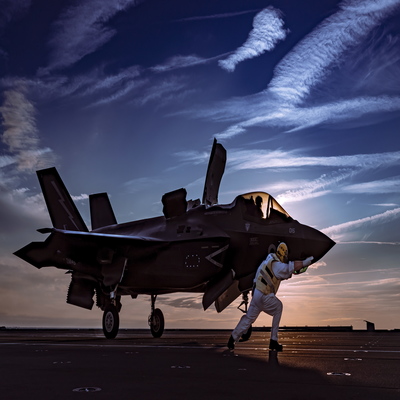This five day course/module focuses on the up-to-date UAV systems level technologies and artificial intelligence based methods for mission planning and energy based range extenders, autopilots. Furthermore, the course covers the connectivities of airworthiness and cyber threat in the modern airspace.
The aim is to provide the students with the understanding of the fundamental concepts and challenges of Uninhabited Aircraft Systems with a military airworthiness perspective. This module is available to attend as a short course or as an elective module as part of the military aerospace and airworthiness module. The course for award bearing students is assessed via 100% coursework and includes group student presentations working in small groups.At a glance
-
- Dates
-
- Please enquire for course dates
- Duration5 days
- LocationCranfield University at Shrivenham
- Cost£2,250 - Standalone Short Course fee
Course structure
A five day course with virtual teaching of theory and expertiseWhat you will learn
In successful completion of the course you will be able to :
- Demonstrate a comprehensive knowledge of the overview of UAS/RPAS and Military Airworthiness,
- Describe the principles of UAV/RPAS passive and active hard subsystems and UAS/RPAS soft methods,
- Estimate flight range of UAS/RPAS based on design and analysis methods,
- Evaluate aspects of UAS/RPAS AI design-based guidance within the context of airworthiness and applications and defence electronics.
Core content
Overview of UAS and Military Airworthiness
UAV/RPAS passive hard subsystems
- UAV/RPAS materials,
- UAV/RPAS structures,
- UAV/RPAS battery and Artificial Intelligence (AI a hard/soft approach),
- Rotary wing vehicles and micro-UAVs.
UAV/RPAS Active Hard Subsystems
- UAV/RPAS communications,
- UAV/RPAS sensing using electro-optics & Infrared,
- UAV/RPAS radar signatures,
- UAS/RPAS design and analysis methods.
UAS/RPAS Soft methods
- Introduction to design and analysis of trials and experiments for UAVs/RPAS,
- Artificial intelligence for UAVs/RPAS,
- Automatic decision making for UAVs/RPAS,
- UAV/RPAS sense and avoid.
UAS/RPAS Design and Analysis Methods
- Principles of UAV/RPAS aero, prop & flight performance,
- Aspects of stealth,
- Stability and control.
UAS/RPAS AI Design Design Based Guidance
- UAV/RPAS sustainable airworthiness – cyber threat,
- UAV/RPAS localisation based on imaging,
- UAV/RPAS energy-based planning guidance artificial intelligence based UAV/RPAS Autopilots for guidance,
- UAV/RPAS guidance.
UAS/RPAS applications and Airworthiness - Test cases
- Applications - artificial sniffing UAV/RPAS for illicit substances,
- UAV/RPAS defence electronics,
- UAV/RPAS airworthiness,
- VR group interactive UAS/RPAS flight experience.
Timetable
This course runs once a year.Upgrade to a professional qualification
When taken as a Short Course for Credit, 10 credit points can be put towards the Military Aerospace and Airworthiness MSc.
Find out more about short course credit points.
Who should attend
The course is suitable for engineers, scientists and managers who would benefit from an overview of UAV development and technology. Both specialists in search of a broader perspective and newcomers to the field will benefit from attending. This is an ideal opportunity for networking with colleagues from the armed services and industry.
Speakers
The instructors are all experts within their fields, with service and industrial backgrounds and are well-versed in explaining clearly the intricacies of their subjects to both the specialist and newcomer.
Course Director
Speakers
- Professor John Economou
- Ajay Kumar
- Dr Lounis Chermak
- Luke Feetham
- Dr Adam Zagoreski
- Dr Licia Dossi
- Dr Trevor Ringrose
- Dr Nalinda Hettiarachchi
- Dr Irfan Khan
- Dr Rachel Hazael
- Dr Simon Place
- Dr Derek Bray
- Professor Kevin Knowles
- Dr Alistair Saddington
- Dr Venkat Sastry
- Dr David Galvao-Wall
- Dr Peter Barker
- Dr Alessio Balleri
- Speaker also include staff from UK MOD
Location and travel
Cranfield Defence and Security (CDS) is a Cranfield School based at the Ministry of Defence establishment on the Oxfordshire/Wiltshire borders.
Shrivenham itself lies in the picturesque Vale of the White Horse, close to the M4 motorway which links London and South Wales. It is 7 miles from Swindon, the nearest town, which lies off the M4 at the hub of Britain’s motorway network.
Bath, Cheltenham, Bristol and Oxford are all within an hour’s drive and London less than two hours away by car.
All visitors must be pre-booked in at reception by the person they are visiting on the campus.
How to apply
To apply for this course please use the online application form.
Read our Professional development (CPD) booking conditions.
